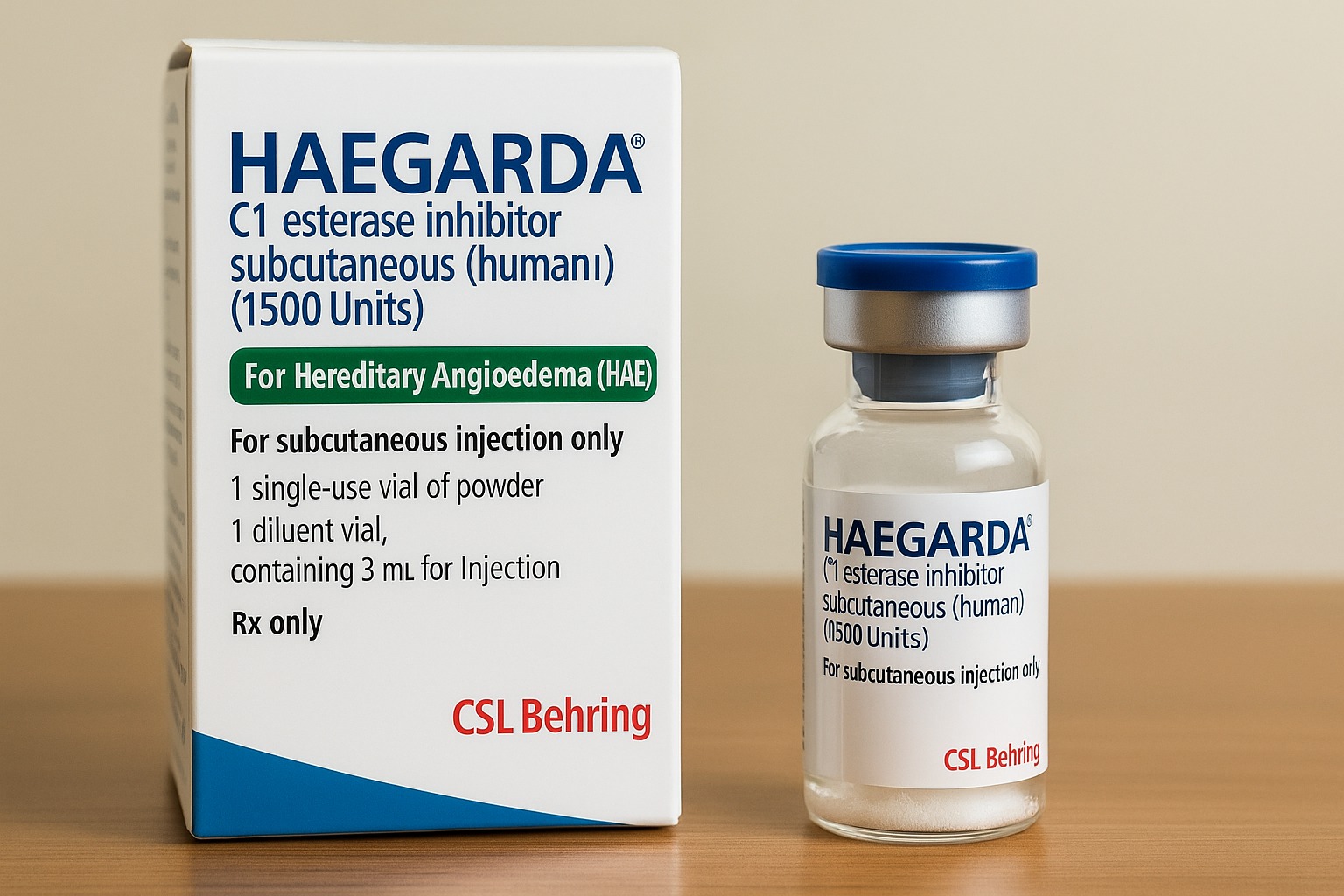Haegarda is a prescription therapy designed to help people with hereditary angioedema (HAE), a rare genetic condition that causes sudden, painful swelling attacks in the body. Its active ingredient is C1 esterase inhibitor (human), which works by restoring a natural protein in the blood that helps regulate swelling. Unlike emergency medications used during an HAE attack, Haegarda is used regularly to prevent attacks from happening in the first place.
This guide explains what Haegarda is, how it works, how it is given, possible side effects, safety tips, and answers to the most common questions patients search for.
Disclaimer: This article is for educational purposes only. It does not replace medical advice. Always follow the instructions of your healthcare provider.
What Is Haegarda?
Haegarda is a subcutaneous (under the skin) injection of C1 esterase inhibitor. It is used as a long-term preventive treatment for hereditary angioedema in patients 6 years and older. By maintaining steady levels of this protein, Haegarda helps prevent the swelling episodes that can affect the skin, abdomen, airway, or other areas.
Available form:
- Haegarda comes as a lyophilized (freeze-dried) powder that must be reconstituted (mixed with sterile water) and injected under the skin.
- It is usually supplied in vials with different strengths, ready to be prepared and injected at home after proper training.
How Does Haegarda Work?
People with HAE have low levels or malfunctioning C1 esterase inhibitor, which normally controls a substance in the body called bradykinin. Too much bradykinin can cause sudden fluid leakage from blood vessels, leading to swelling.
Haegarda works by:
- Replacing the missing C1 esterase inhibitor in the blood.
- Blocking excess bradykinin production.
- Helping prevent swelling attacks before they occur.
Because it is given regularly, Haegarda keeps levels steady, lowering the frequency and severity of HAE episodes.
Common Uses of Haegarda
Doctors prescribe Haegarda to:
- Prevent recurrent swelling attacks in people with hereditary angioedema (HAE).
- Provide a long-term maintenance therapy so patients can live with fewer interruptions caused by sudden swelling episodes.
It is not used for treating acute attacks. For emergencies, doctors may prescribe separate on-demand rescue medications.
Haegarda Dosage and Administration
Your healthcare provider will decide the exact dose and schedule. Typical guidance includes:
- Dose: Often weight-based, given every 3–4 days by subcutaneous injection.
- Administration: Haegarda is injected into the fatty tissue under the skin (commonly the abdomen). It should not be given into a vein or muscle.
- Home use: Many patients learn self-injection at home with training from their healthcare provider.
What to Expect on Injection Day:
- Wash hands and prepare a clean work area.
- Reconstitute the powder with sterile water as instructed.
- Draw the solution into a syringe and attach the injection needle.
- Inject slowly under the skin at the recommended site.
- Dispose of all supplies safely in a sharps container.
Side Effects of Haegarda
Like all medicines, Haegarda may cause side effects. Most are mild and related to the injection itself.
Common side effects:
- Injection site reactions (pain, redness, swelling, itching)
- Headache
- Fatigue
Less common but important:
- Hypersensitivity or allergic reactions (rash, hives, difficulty breathing)
- Blood clots (rare)
Always contact your doctor right away if you experience unusual symptoms.
Warnings and Precautions
- Allergies: Do not use Haegarda if you have had severe allergic reactions to C1 esterase inhibitor products.
- Blood clots: Patients with clotting risk factors should be monitored closely.
- Pregnancy & breastfeeding: Limited data is available; use only if clearly needed.
- Children: Approved for ages 6 and older.
- Infections: Since it is made from human plasma, Haegarda undergoes viral inactivation steps, but there is a very small theoretical risk of transmitting infections.
Haegarda vs Other HAE Treatments
- Haegarda (C1 esterase inhibitor, subcutaneous): Preventive, given 2–3 times weekly at home.
- Cinryze (C1 esterase inhibitor, intravenous): Preventive, given into a vein.
- On-demand medicines (like icatibant or ecallantide): Treat acute attacks, not prevention.
Haegarda offers convenience because it is injected under the skin, not into a vein, and can be used at home.
Cost, Access & Insurance
- Haegarda is prescription-only and often requires prior insurance approval.
- Patient assistance programs may be available to reduce costs.
- Specialty pharmacies usually supply it and provide injection training.
Proper Care With Haegarda
Before treatment:
- Review your medical history with your doctor (allergies, clotting risks, other medicines).
- Ask about financial support and injection training.
During treatment:
- Stick to your dosing schedule.
- Record injection dates and any side effects in a treatment diary.
- Rotate injection sites to avoid irritation.
When to call your doctor immediately:
- Difficulty breathing or swallowing
- Severe headache or chest pain
- Signs of blood clot (leg pain, swelling, sudden shortness of breath)
Frequently Asked Questions (FAQs)
Q1. How often is Haegarda taken?
Most patients inject it every 3–4 days, based on their doctor’s instructions.
Q2. Can I inject Haegarda myself?
Yes, with training from your healthcare provider, you can self-inject at home.
Q3. Does Haegarda stop an HAE attack?
No. It is for prevention only. Separate rescue medication is needed for sudden attacks.
Q4. Is Haegarda safe for children?
Yes, it is approved for patients 6 years and older.
Q5. How soon does Haegarda start working?
Many patients notice fewer attacks within weeks of starting therapy, but results vary.
Final Thoughts
Haegarda is an important therapy for people living with hereditary angioedema, offering reliable prevention of painful and sometimes life-threatening swelling episodes. With proper training and consistent use, it allows patients more freedom and stability in daily life. Always work closely with your healthcare team to monitor safety and ensure the best results from treatment.


Leave a Comment